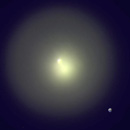UK Astronomers Home in on Exploding Comet
UK astronomers using the Isaac Newton Telescope (INT) in La Palma have been
tracking a comet that has brightened by a factor of a million over the last
week, enabling it to be seen with the naked eye.

Comet
Holmes enhanced to show the expanding cloud of dust.
(Credit: T Naylor / A Fitzsimmons / C Brunt /
ING)Last Monday night, Comet Holmes was a very faint object that needed a large
telescope to see it. On Tuesday night, two amateur astronomers in the Canary
Islands spotted it had suddenly got much brighter. Over the next 24 hours it
continued the trend until it had brightened by a factor of a million and could
clearly be seen without a telescope!
The comet is easy to see with by eye, as long as you are not in the centre of
a large town or city. It appears as a small fuzzy object as bright as a
medium-brightness star in the constellation Perseus. It is visible in the early
evening after dark in the north east sky, and is directly overhead by 1 o'clock
in the morning.
As word spread around the globe, Professor Alan Fitzsimmons of Queen's
University Belfast knew this was a once in a lifetime event and scrambled to
find a telescope that could observe this phenomenon. "Although comets have been
seen to undergo outbursts before, the scale of this dwarfed anything seen in the
past century", he said.
Luckily, Professor Tim Naylor and PhD student Cameron Bell from The
University of Exeter were using the 2.5m Isaac Newton Telescope (INT) that
evening. "Comets are not normally my thing" said Prof. Naylor who usually
studies star formation, "but it was an interesting technical challenge to
observe something so bright with a large telescope."
“On the first night we were only able to do it thanks to a filter left over
from an old cosmology project which we used to cut down the light. It’s the
first time I've walked out of the control room, estimated by eye how bright an
object is, and then set my exposure time accordingly. The most fascinating bit
was watching the nucleus gradually separate from the cloud of dust, and
realising just how far out of the ordinary this comet is."
The images from the INT show an expanding circular cloud of gas and dust
emanating from the nucleus of the comet, together with a brighter cloud of
material. Professor Fitzsimmons said "From these images we can see the ejecta
moving away from the comet at 2,000 km per hour (1,300 miles per hour). The
total amount of material ejected is probably about 1% of the total mass of the
comet. On a smaller scale, it is like the Earth suddenly threw off its
crust."
It is not clear what caused this explosive event. One possibility is that it
was hit by a meteoroid. More probably there has been a build-up of gas under
part of the surface that catastrophically ruptured the surface last week.
Astronomers are now studying the event to try and determine the cause. There
is always the possibility of another outburst as well. "When this comet was
discovered in 1892 it was also undergoing an outburst" noted Professor
Fitzsimmons. "It underwent another one just ten weeks later. We'll have to keep
an eye on this one."
Also taking part in this study are Dr. Colin Snodgrass of the European
Southern Observatory, Dr. Hermann Boehnhardt of the Max-Planck Institute for
Solar System Research, and Dr. Tim Lister of the Las Cumbres Observatory.
Contacts
- Gill Ormrod
Science and
Technology Facilities Council
Press Office
Tel: +44 (0)1793 442
012
Mobile: 0781 8013 509
- Prof Alan Fitzsimmons
Astrophysics Research Centre
Queen's University Belfast
Tel: +44
(0)2890 973 124
- Prof Tim Naylor
School of
Physics
University of Exeter
Tel: +44 (0)1392 264 151
- Javier Mendez
ING Public Relations
Officer
Images
Image -
Comet Holmes enhanced to show the expanding cloud of dust from the outburst more
clearly. The Earth is shown to scale at the lower right.
Credit: T.
Naylor/A.Fitzsimmons/C.Brunt/ING
Further images of the comet, the telescope and a sky map showing where the
comet can currently be observed are available from Gill Ormrod in the STFC press
office (contact details above).
Further information
Comets are small icy bodies that orbit our Sun. When near the Sun, the comet
warms and ices on the surface 'boil off' to form its atmosphere and tails. Over
a thousand comets have been discovered orbiting our Sun.
Comet 17P/Holmes was discovered in 1892 by British amateur astronomer Edwin
Holmes. It takes 6.9 years to orbit the Sun once, and does not come close to the
planet Earth. Comet Holmes is currently 244 million kilometres from Earth and
368 million kilometres from the Sun.
The Isaac Newton Group of Telescopes (ING) operates the 4.2m William Herschel
Telescope (WHT), the 2.5m Isaac Newton Telescope (INT) and the 1.0m Jacobus
Kapteyn Telescope (JKT) on behalf of the Science and Technology Facilities
Council (STFC) of the United Kingdom, the Nederlandse Organisatie voor
Wetenschappelijk Onderzoek (NWO) of the Netherlands, and the Instituto de
Astrofísica de Canarias (IAC) in Spain. The ING is located at the Roque de Los
Muchachos Observatory, La Palma.
About STFC
Page last updated: 31 October 2007 by Gill Ormrod